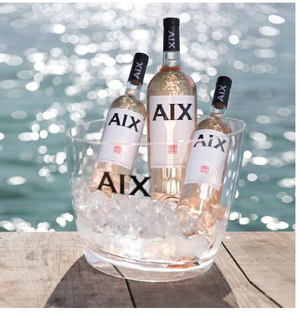While Provence may be the
world leader in Rosé production, the style is also made in wine regions around
the globe. Often thought of as cheap and cheerful, the production of pink vino
may be more complex than expected, as the vinification process borrows from
both red and white winemaking techniques and some varietals are even produced
using more than one method.
Rosé can be made in the Saignee Method which
is named after the French word Saigner which means “to bleed.” This
process requires red grapes to be lightly crushed, allowing the released juice
to macerate with the red skins to obtain the pink color before “bleeding off”
the liquid for fermentation. This process allows winemakers to obtain a
spectrum of rosy-colored hues depending on the length of time the grape skins
are in contact with the juice.
The remaining grape juice may then be allowed
to continue to macerate with the skins for longer so a red wine can also be
produced with more concentrated flavors. This method is more common in new
world wine regions.
 More lightly tinted rosé comes from the free
run juice that is obtained from a harder pressing of clusters of red grapes
followed by a quick collection of the juice before it can pick up too much
anthocyanin, or natural colorant, from the skins. This paler hued juice is then
fermented like a white wine to maintain the more delicate shade. This is how
rosé is primarily produced in Provence.
More lightly tinted rosé comes from the free
run juice that is obtained from a harder pressing of clusters of red grapes
followed by a quick collection of the juice before it can pick up too much
anthocyanin, or natural colorant, from the skins. This paler hued juice is then
fermented like a white wine to maintain the more delicate shade. This is how
rosé is primarily produced in Provence.
Mixing red and white wine together to make a
rosé wine is uncommon except in sparkling wine production. In Champagne, for example, the wine is produced
as a white wine and then still red wine from Pinot Noir is added to obtain a
very precise color that reflects the house style.
Most wine regions produce some rosé wines,
and they typically use the dominant red grapes grown there. This means that
consumers can find pink wines made from a wide variety of grapes in a broad
array of hues - from the palest of onion-skin pink typically found in Provence blends, to the deep, fuller bodied
cherry-colored wines called Cerasuolo, made in Abruzzo, Italy
from dark Montepulciano grapes.
Texas
continues to have great success with rosé wines, as well, using an
ever-increasing expansive array of grape varieties to create a rainbow of pink
wines. Rosé aficionados can find pinks made from Tempranillo, Aglianico,
Sangiovese, Mourvedre, and even Cabernet and Merlot.
The best of these wines can be ordered
directly from the winery websites. A good choice is the 2018 Perissos Italian
Stallion Rosé which is made from a blend of Texas grown Italian grapes sourced from the
High Plains. It is a bit more expensive at $36 a bottle, but well worth the
price for a true Texan wine lover.
Regardless of a rosé wine’s origin, they all
tend to have some commonalities. The best selections are dry, refreshing, and
food friendly. They should always be served well-chilled whether sipping alone
or serving with a meal. They should work with a wide variety of food whether
seafood, salad, Mexican, or Asian is on the menu. This spring, think pink and
rosé all day.
 Top Picks on the Island now, all under $20
Top Picks on the Island now, all under $20
2018 AIX en Provence- This classic
rosé is the top pick from the local wine guys at Economy Liquor. The nose is
fragrant yet delicate with notes of watermelon, strawberries, and a
hint of flowers with a crisp, fresh finish. It is created using 30% rosé bleeding and 70% direct pressing using traditional regional grapes in a blend
of Grenache, Syrah, Cinsault, and Carignan. The
winery refers to this wine as “an affordable everyday luxury.”
2018 Muga Rioja Rosado-
In Spain, Rosé wines are called rosado. This dry, salmon pink wine is a
blend made from Garnacha (the Spanish word for Grenache), Viura, and
Tempranillo. It is loaded with raspberry and strawberry aromas and flavors.
It spends three months with the yeast before bottling to give it a pleasant,
softer, round feel for fresh and easy drinking. Find it at Spec’s.
Gruet
Brut Rosé-
This domestic méthode champenoise sparkling wine is from New Mexico. It is made
from Pinot Noir using both the Saignee method and then adding 2% still Pinot
Noir wine to the blend to deepen the garnet-pink
color. This non-vintage sparkling wine has an elegant mousse and rich berry flavors
with a fuller body and zesty acidity that makes it pleasant to drink alone or
to enjoy with a meal. Find it on the shelf at both Spec’s and Economy Liquor.